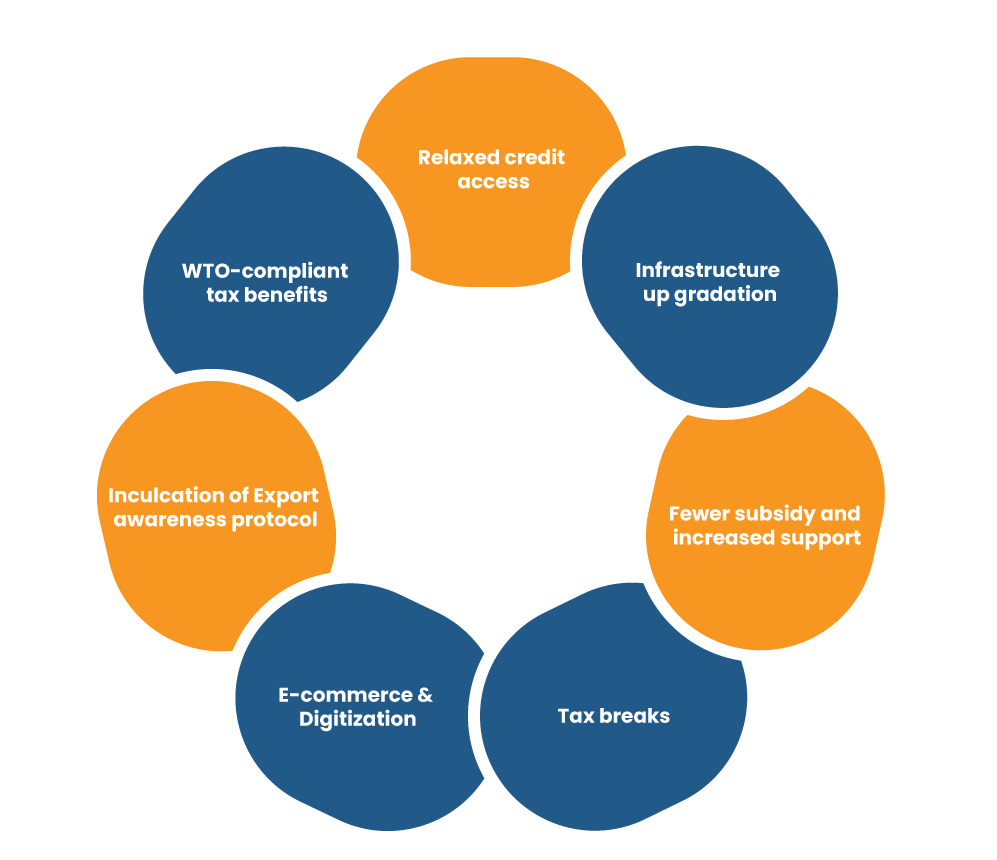The Government has extended the released date for the new Foreign Trade Policy 2021-2026. Owing to an ongoing pandemic, the Government has decided to stick with the existing Foreign Trade Policy till September this year. The new Foreign Trade Policy was expected to unveil some growth-driven announcements with significant stress on the export promotion.
The foreign trade policy (aka FTP) specifies government strategies and aims to promote export and domestic production to augment the nation’s GDP. It will be interesting to see how the new Foreign Trade Policy gets affected as India continues to battle the second wave of the pandemic. The revelation of this policy is eagerly awaited in such testing time.
According to the UN World Economic Situation & Prospect 2021 report, the economy of India has shrunk 9.6% in the FY 2020 against a global average of 4.3%. However, the same report projects a growth of 7.3% in 2021. The hopes for a positive shift rest primarily on export activities picking up.
Exporters anticipate the new Foreign Trade Policy to entail growth-oriented initiatives and have the potential to improve the nation’s standing in the global merchandise & services exports.
Underlining Declarations made by Ministry of Commerce under new FTP
For the time being, the Government seems committed to proactively working towards its $5-trillion dream. While addressing MPs about Foreign Trade Policy 2021-2026 on Jan 12, the Ministry of Commerce unveiled some of its plans for the new Foreign Trade Policy. These include:
Read our article:How to Export Goods from India to Overseas Markets?
Correcting imbalances
A continual demand of exporters/importers is rectifying the imbalances in the global trade processes. At the meeting, the ministry promised to reduce “local & foreign framework for lessening transaction cost & promoting ease of doing business”.
It also emphasized the creation of cost-effective, efficient & adequate logistical & utility infrastructure”.
District Export Hubs
The Government shall pinpoint potential products & services in each district, identify toy clusters & agricultural, map GI products, establish district export action & district export promotion panels as part of this initiative targeted at farmers & small businesses.
Foreign Trade Policy 2021-2026: What to Expect?
Covid-19 is detrimental to global trade. In FY 2020, India has registered a record decline of 60 % and 59 % in terms of export and import, respectively. Though there has been some recovery, the road to complete turnaround is long and hard. That is why everybody is expecting the new Foreign Trade Policy to make some ground-breaking move. Following are the key expectation from the new Foreign Trade Policy based on the input from members of Parliament, high-level advisory group, trade associations, and traders.


WTO-compliant tax benefits
With incentives under SEIS & MEIS under the cloud, the WTO-compliant tax benefits are eagerly awaited. To this end, the Government has unveiled RoDTEP, i.e. Remission of Duties or Taxes on Export Products scheme, on Jan 1, 2021. However, the rates & the conditions of the schemes are still under the cloud.
Relaxed credit access
Accessibility to credit has remained the long-standing demand of exporters. Under the non-availability of collateral, MSMEs are less likely to get credit from mainstream financial institutions. The policy can open the door to easy credit options such as financial technology start-ups. The advisory group recommends increasing the borrowing limit at the EXIM bank of India.
Infrastructure up gradation
For years, China has outweighed other nations in terms of export because of its unprecedented domestic infrastructure. India has a lot to learn from China in this context. At present, India must consider improving its dwindling infrastructure through the up-gradation of existing ports, warehouses, certification centres, etc.
The scheme, viz Infrastructure for Export Sector, was introduced by GOI in FY 2017 to promote exports for the period of 3 years. Many industry experts are hoping for the extension of the same.
Fewer subsidy and increased support
In FY 2020, the honorable Commerce Minister states that subsidies are less likely to play a vital role in increasing the overall trade. The factors like quality, the scale of production & technology shall be game-changer in this regard. Most industry experts also agreed to this paradigm.
Likewise, the trade policy could entail incentives focusing on R&D, something the Government emphasized in the past. From the technology standpoint, the Amended Technology Upgradation Fund Scheme – that entirely focused on improving productivity, investment, exports & quality in the textile industry via technology upgrades – can be passed on to other sectors.
Tax Breaks
If India were opted out of subsidies, exporters would still seek some resilience from the Government. Easier & reduced taxes could fill this gap. The simplification of duty structures & reduction of corporate tax rates is long-standing demands.
The Confederation of Indian Industry advises simplifying import duty structure via higher duties on finished goods & reduced duties on raw material & intermediates. There have been consistent demands for an overhaul of prevailing schemes such as Duty Drawback & EPCG.
E-commerce &Digitization
With Covid-19 hampering conventional supply chains, India seeks upgraded trade practices. E-commerce & Digitization could offer great resilience in this regard. Digitization can be a game-changer as it can speed up stubborn import-export processes by mitigating manual intervention.
The Nasscom, an apex government institution, suggests a web-based portal for Import Export Code holders to modify basic details such as email ID and contact number.
It also makes a case of advocating e-commerce exports by;
- Inculcating e-commerce export portal under Niryat Bandhu (a scheme for mentoring new business aspirants in global trade
- Inculcating e-commerce export promotion cells under the ambit of export promotion councils
- Inculcating e-Commerce Export Zones to encourage MSMEs.
Inculcation of Export awareness protocols
Sometimes, the lack of awareness regarding trade opportunities acts as a major deterrent to the Indian exporters. There is a need for a sound trade policy that embraces new awareness practices for traders regarding global markets, IPRs, international laws and standards, patents, and geographical indication (GI).
Regulatory Relaxation for Importers
The overall development of the trading regime does not only depend on export but also import activities. At present, the importers in India are confronting a heap of limitations that acts as a deterrent for their business. For the time being, these importers are in desperate need of certain measures such as;
- Permission for the importation of capital goods on a self-certification basis
- Inculcation of Central government[1]-approved Board of Approval for the importation of prohibited goods
Conclusion
It’s expected that the new Foreign Trade Policy 2021-26 will fit well to the Government’s commitment of a $5-trillion economy. However, it would be interesting to see how it will works in a real-world scenario, given the ongoing pandemic.
Read our article:How to obtain IEC Code in India













